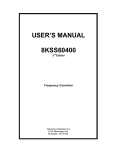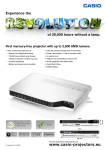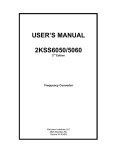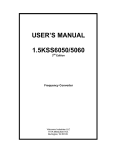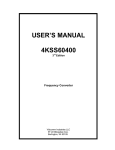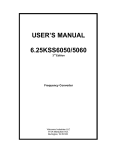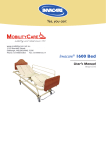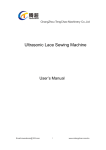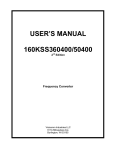Download USER`S MANUAL FC10KLAC5B
Transcript
USER’S MANUAL FC10KLAC5B 4th Edition Frequency Converter Visicomm Industries LLC 4525 Sheridan Rd. Racine WI 53403 1. INTRODUCTION The conversion of electrical power is an essential requirement for export testing or operation of equipment brought to the U.S. from abroad. The KSS series Frequency Converter is designed to meet these needs as it supplies reliable, pure and stable power at an affordable price. This Converter is designed with the following unique features l Double Conversion IGBT module, Single control board design, eliminates adjustment, and minimizes maintenance. l LCD display for unit status, user friendly design l Special overload capacity design, 150% overload for 30 sec. l Built-in isolation transformer to ensure total isolation between the input and output. l Special airflow control to avoid dust accumulation. Suitable for rough operating environments. l Front door access for ease of installation and servicing. l Compact size, light weight The complete package includes: 1. 2. 3. 4. 5. Main Converter x 1 User ’s manual x 1 Front door key x 1 Battery Bank x 1 Screw to secure battery plug to battery receptacle box 1 2.1 FRONT PANEL 11. LCD Display Selector Switch 12. Frequency Selector Switch 13. Main Input breaker (SW1): Controls the A C commercial input power, in addition this breaker trips if the output power is subjected to a dead short. 14. Input terminal: The input power leads will be connected to the terminal block. Either 110VAC range or 220VAC range (See Specification Sheet). 15. Output Terminal, Two (2) ranges: 120VAC L-N, 240VAC L-N (See Specification Sheet). 16. Output Voltage Adjustment potentiometer 17. Ground Terminal 18. Battery Breaker FC10KLAC5B FREQUENCY CONVERTER (FRONT) 2 3 4 BATTERY (Front) FREQUENCY CONVERTER (FRONT) FREQUENCY CONVERTER (BACK) BATTERY (Back) 5 This is NOT a split phase input. If using a U.S. 220VAC input with no neutral, connect one hot lead to N, and one hot lead to L2. IMPORTANT NOTE: INPUT - OUTPUT CONNECTIONS Input Power Connections and Grounding S ystem Ground Connection: The Earth Ground should be provided by the utility. This is normally the “GREEN” wire provided by the utility which at some point is routed to a secure earth ground such as a water pipe. This wire should be connected to the screw post marked GND on the Converter (See photo for location). Note that there are no internal electrical connections to this wire with the exception of a small high frequency bypass capacitor for RF suppression. Therefore, the function of the Earth Ground is simply to maintain the case of the Converter at ground potential. Visicomm Industries (LLC) does not recommend any other connection to the Earth Ground wire which may introduce significant amounts of current and thereby defeat the intended purpose of this wire which is the safety of the operating personnel. In particular, do not connect this wire to the system neutral wire at any point. Output Connection: The Power OUTPUT Connections are provided by three barrier terminal posts labeled N, L1, and L2. These three terminals constitute the three terminals of an internal auto-transformer were L1 is the “center tap”. This is fed by the output winding of a switching transformer. Since the only other internal connections are a resonating capacitor, the cooling fans, and sensing circuits( to maintain an output sine wave ), these output terminals are electrically isolated from any other circuits including the system neutral. The Converter is shipped with these OUTPUT connections electrically isolated. If a digital voltmeter is connected between any one of these OUTPUT terminals and the Earth Ground, a significant voltage reading will be obtained. This voltage is due to a small leakage current and is not considered a problem since only 1 or 2 ma is involved. Output Isolation: Many applications require an isolated output, primarily for safety reasons, when supplying power to a device under test especially if there will be other monitoring equipment connected to the device. Other applications can take advantage of the low leakage current of the Converter (about 1 or 2 ma). This can be useful in systems where the individual leakage currents of the components might exceed the allowed leakage current of a ground fault interrupter. Other applications require that the output have a connection to the utility NEUTRAL. Normally this would be OUTPUT terminal N (The exception would be a two phase output where L1 would be the connection to the system NEUTRAL). The Converter is supplied with a short jumper wire. If the system NEUTRAL is used to power the INPUT terminals and it is required that the OUTPUT be connected to NEUTRAL this jumper can be employed to make this connection. If the INPUT is supplied by two phase AC or by two phases of a three phase system (in other words, if you have only two incoming power wires), this NEUTRAL would not be present and an external wire from the desired OUTPUT terminal to the system NEUTRAL would be required. See INPUT CONNECTION DIAGRAM on next page. N L1 L2 Basic diagram of output stage 6 INPUT POWER CONNECTIONS The frequency of the input power can be 50 or 60 Hz, and is not related to the output frequency CAUTION: The Input is Electrically Isolated from the output. It is necessary to connect the input using one of the following four methods. A. SINGLE PHASE 220V INPUT This connection is usually used in 50Hz countries where a neutral is normally available. B. SPLIT PHASE 220V INPUT This connection is usually used in 60Hz countries where a 220V line is not normally available, and where the input amperage makes using 120V inconvenient. C. SINGLE PHASE 120V INPUT D. THREE-PHASE 120/208VAC USING LINE TO LINE INPUT To be used if the 120V line to neutral connection is limited by the amperage available. 7 OUTPUT POWER CONNECTIONS The frequency of the output power can be 50 or 60 Hz, and is not related to the input frequency CAUTION: The output is "floating" and is electrically isolated from the input. It is necessary to connect the output using one of the following three methods. Note that these output voltages are widely adjustable using the voltage adjust rheostat. A. SINGLE PHASE 120V OUTPUT B. SINGLE PHASE 220V OUTPUT C. SPLIT PHASE 220V OUTPUT 8 4. SPECIFICATION Model FC10KLAC5B Capacity Input 10KVA/8KW Voltage 120 or 220VAC -15%/+20% Frequency 50 Hz or 60 Hz ± 5% Voltage 120 or 220VAC ± 20 % (adjustable) Frequency 50Hz or 60Hz (400Hz available) Voltage Regulation ± 1 % Power Factor ± 0.5% ± 3% (100% Load variation) No load to full load with full recovery within 5 cycles Sine wave THD < 3% at 0-100% linear load Overload Capacity 110% continuous, 110-150% load 30 seconds, over 150% causes unit to shut down. Auto restart upon removal of the overload 0.8 Crest Ratio 3:1 Output Battery Frequency Stability Transient Response Waveform Voltage 192VDC Type Sealed Lead Acid, maintenance free, 12VDC/7AH Recharge Time 8-10 hours to 90% capacity Efficiency AC to AC > 85% Battery Time 1 Minute @ full Load Protection Audible Alarm Indicators Environment Battery Battery Low shutdown and breaker Overload 150% 30sec cut off (Current Limited) Short Circuit Unit will cut-off and must be manually restarted EMI Filter 10-100KHz at 40dB, 100KHz-100MHz at 70dB Mains Failure Sounds Every 4 sec. After mains fail, mute after 90 sec. Battery Low Sounds Every second when battery approaches low level Overload Sounds continuously Fault Sounds continuously LCD Operation Temp. Converter status, I/P & O/P voltage, I/P & O/P frequency Line: Green LED Inverter: Green LED Fault: Red LED Overload: Yellow LED -10-50ºC; 14 -122ºF Relative Humidity 20-90% non-condensing Audible Noise Less than 58dB (at 1 meter) LED Input Output Physical Dimensions Terminal Block Terminal Block (Worldwide outlets available) Net Weight 366lbs / 165kg Width 18.90” / 48cm Depth 13.39” / 34cm Height 30.77” / 84cm 9 WARNING Only a qualified technician should replace the battery. Batteries have a high short-circuit capacity. Mistakes in connecting or disconnecting the batteries can cause connections to arc or weld and could result in severe burns. • • • Please keep battery fully charged to extend battery life. There are no customer serviceable components inside. Don’t open the cover or attempt to service the unit on your own. High Voltage may be present even when the unit is shut down. Please follow all operational instructions. STORAGE The converter should only be stored if the battery is fully charged. Avoid storage temperatures above 80ºF, as battery life is significantly shortened. Every 90 days remove the unit from storage and plug in for 24 hours to recharge the batteries. Batteries may be damaged if left in storage and not recharged every 90 days! IMPORTANT NOTICE Please use same type and same power rating of batteries for replacement. Do not attempt to replace with batteries that exceed the specified ratings! 10 5. BATTERY FACTS The batteries are the only serviceable parts in the converter. The e xpected life of the battery is approximately 3-5 years. However, frequent long discharges or ambient temperatures above 80 ºF will shorten battery life. Therefore, it is recommended to replace the batteries every 3 years after initiating the unit. Recharge the batteries every 3 months if not in use, as the batteries have a self discharge characteristic. 5.1 BATTERIES AND RECHARGING 1. Batteries will automatically recharge when the converter has AC input power applied, and input breaker (SW1) and battery br eaker (SW2) are both on. Typical time: about 8-10 hours to 90% capacity. FIG 5-1 BATTERY BACKUP TIME CHART 2. Please contact Visicomm if a battery bank with longer backup times are required. 11












